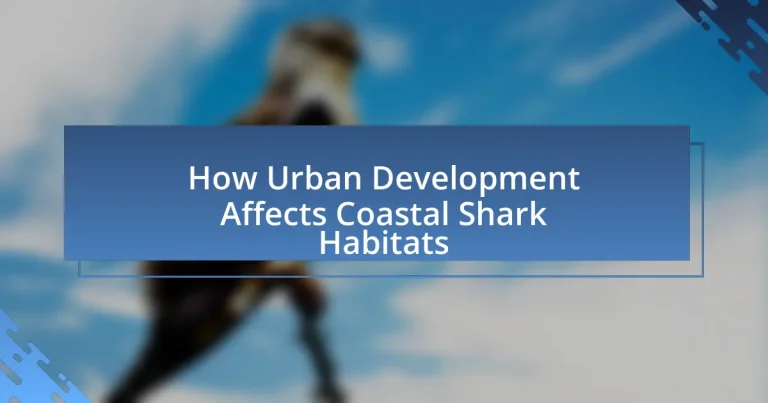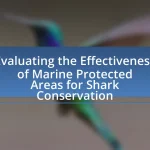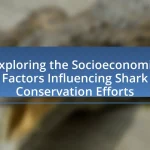Urban development significantly impacts coastal shark habitats by causing habitat loss, degradation, and increased pollution. Key activities such as coastal construction, land reclamation, and urban runoff disrupt essential breeding and feeding grounds for sharks, leading to declines in their populations. The article examines the primary effects of urbanization on marine ecosystems, the role of sharks in maintaining ecological balance, and the specific threats posed by increased boat traffic and noise pollution. It also discusses strategies for sustainable urban planning, community engagement, and best practices for developers to mitigate environmental impacts and support shark conservation efforts.
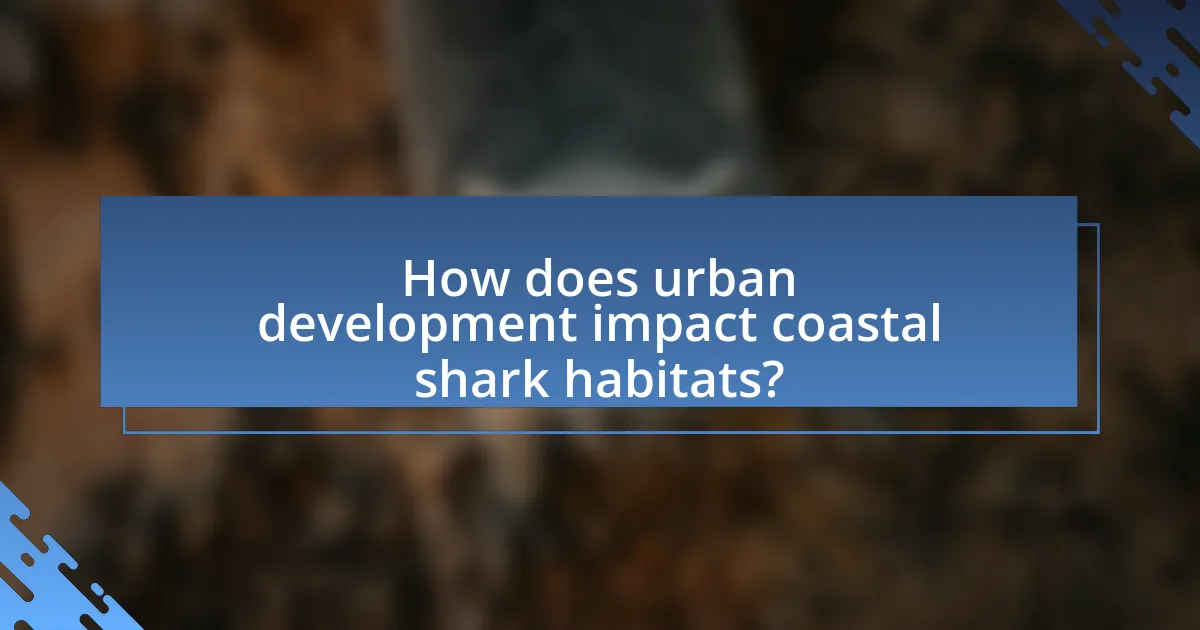
How does urban development impact coastal shark habitats?
Urban development negatively impacts coastal shark habitats by altering their natural environments and disrupting their breeding and feeding grounds. Coastal construction, such as the building of marinas and residential areas, leads to habitat loss and fragmentation, which can reduce the availability of essential resources for sharks. Studies indicate that increased sedimentation from urban runoff can smother coral reefs and seagrass beds, critical habitats for many shark species. Additionally, urbanization often results in increased boat traffic and pollution, which can further stress shark populations and lead to declines in their numbers.
What are the primary effects of urbanization on marine ecosystems?
Urbanization primarily affects marine ecosystems through habitat degradation, pollution, and altered water flow. Habitat degradation occurs as coastal areas are developed for infrastructure, leading to the destruction of critical habitats such as mangroves, seagrasses, and coral reefs. Pollution from urban runoff introduces harmful substances, including heavy metals and nutrients, which can lead to eutrophication and harmful algal blooms, negatively impacting marine life. Additionally, urbanization alters natural water flow patterns, disrupting sediment transport and affecting the ecological balance of marine environments. Studies indicate that these changes can lead to declines in biodiversity and the health of marine species, including sharks, which rely on healthy ecosystems for breeding and feeding.
How does increased pollution from urban areas affect shark populations?
Increased pollution from urban areas negatively affects shark populations by degrading their habitats and reducing prey availability. Pollutants such as heavy metals, plastics, and nutrients can lead to habitat destruction, particularly in coastal ecosystems where sharks breed and hunt. For instance, studies have shown that runoff from urban areas can cause harmful algal blooms, which deplete oxygen levels and create dead zones, making these areas inhospitable for both sharks and their prey. Additionally, the presence of pollutants can lead to bioaccumulation in marine food webs, impacting shark health and reproductive success.
What role does habitat destruction play in the decline of coastal sharks?
Habitat destruction significantly contributes to the decline of coastal sharks by reducing their breeding and feeding grounds. Coastal development, such as construction and pollution, leads to the degradation of essential habitats like mangroves and coral reefs, which are critical for shark populations. Studies indicate that over 50% of mangrove forests have been lost globally, directly impacting the biodiversity and health of marine ecosystems, including shark species that rely on these areas for nursery habitats. Furthermore, the loss of these habitats disrupts the food chain, making it harder for sharks to find prey, ultimately leading to population declines.
Why is it important to study the relationship between urban development and shark habitats?
Studying the relationship between urban development and shark habitats is crucial because urbanization significantly impacts coastal ecosystems, including the habitats that sharks rely on for breeding, feeding, and shelter. Urban development often leads to habitat degradation, pollution, and changes in water quality, which can adversely affect shark populations. For instance, research indicates that coastal development can reduce the availability of essential nursery habitats for juvenile sharks, leading to decreased survival rates. Understanding this relationship helps inform conservation strategies and urban planning to mitigate negative impacts on shark populations and maintain biodiversity in marine ecosystems.
What ecological functions do sharks serve in coastal environments?
Sharks serve critical ecological functions in coastal environments by maintaining the balance of marine ecosystems. They act as apex predators, regulating the populations of prey species, which helps to prevent overgrazing of seagrass and coral reef habitats. This predation supports biodiversity by allowing various species to thrive and maintain healthy ecosystems. For instance, studies have shown that the presence of sharks can lead to increased abundance and diversity of fish species, as their predation pressures help control the populations of smaller fish and invertebrates. Additionally, sharks contribute to nutrient cycling through their feeding habits, which can enhance the overall productivity of coastal waters.
How do changes in shark populations influence marine biodiversity?
Changes in shark populations significantly influence marine biodiversity by altering the dynamics of marine ecosystems. Sharks are apex predators, and their presence helps maintain the balance of species below them in the food chain. For instance, a decline in shark populations can lead to an increase in smaller predatory fish, which may overconsume herbivorous species, resulting in the degradation of seagrass beds and coral reefs. This phenomenon has been documented in various studies, such as the research by Ferretti et al. (2010) published in “Conservation Biology,” which highlights how the removal of sharks can lead to cascading effects on marine biodiversity and ecosystem health. Thus, the health of shark populations is crucial for sustaining the overall biodiversity of marine environments.
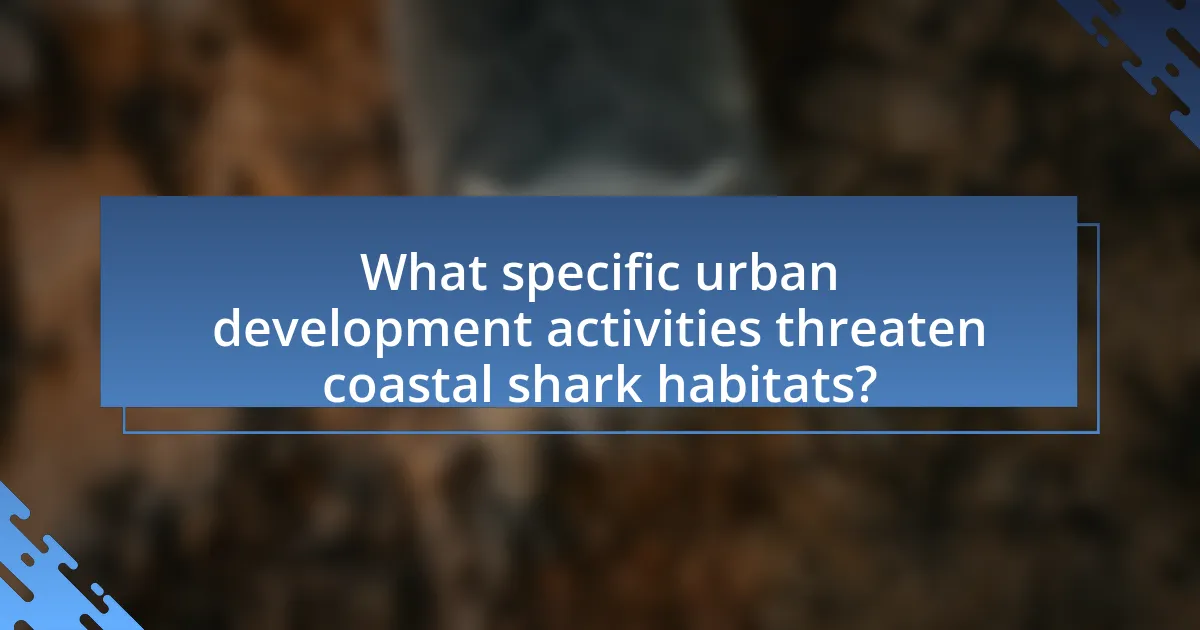
What specific urban development activities threaten coastal shark habitats?
Specific urban development activities that threaten coastal shark habitats include coastal construction, land reclamation, and pollution from urban runoff. Coastal construction, such as building marinas and seawalls, disrupts natural habitats and alters the ecosystem, making it less suitable for sharks. Land reclamation projects, which involve filling in coastal areas for development, destroy critical nursery habitats essential for shark populations. Additionally, pollution from urban runoff introduces harmful chemicals and sediments into coastal waters, negatively impacting water quality and the health of marine life, including sharks. Studies have shown that these activities lead to habitat degradation, which is detrimental to shark populations and their reproductive success.
How does coastal construction impact shark breeding grounds?
Coastal construction negatively impacts shark breeding grounds by disrupting essential habitats and altering environmental conditions. Activities such as dredging, land reclamation, and the building of infrastructure can lead to habitat loss, increased sedimentation, and changes in water quality, which are detrimental to the reproductive success of sharks. For instance, studies have shown that increased turbidity from construction can hinder the ability of sharks to locate prey and suitable breeding sites, ultimately affecting their population dynamics. Additionally, the introduction of pollutants from construction sites can degrade water quality, further stressing shark populations that rely on clean, stable environments for breeding.
What types of construction are most harmful to shark habitats?
Coastal construction, particularly the development of marinas, seawalls, and urban waterfronts, is most harmful to shark habitats. These types of construction disrupt natural ecosystems, reduce water quality, and alter essential habitats such as nurseries and feeding grounds. For instance, the construction of marinas can lead to increased boat traffic and pollution, which negatively impacts shark populations by degrading their environment and reducing prey availability. Studies have shown that urban development along coastlines can lead to habitat fragmentation, making it difficult for sharks to migrate and reproduce effectively.
How can construction practices be modified to protect sharks?
Construction practices can be modified to protect sharks by implementing measures such as creating buffer zones, using environmentally friendly materials, and minimizing coastal development. Buffer zones, which are areas left undeveloped between construction sites and coastal waters, help reduce habitat disruption and pollution runoff that can harm shark populations. Environmentally friendly materials, such as non-toxic paints and sustainable building supplies, decrease the likelihood of harmful substances entering marine ecosystems. Additionally, minimizing coastal development through regulations and planning can preserve critical habitats for sharks, as studies show that urbanization often leads to habitat loss and degradation, negatively impacting shark populations.
What is the effect of increased boat traffic on coastal sharks?
Increased boat traffic negatively affects coastal sharks by disrupting their natural behaviors and habitats. The presence of boats can lead to increased stress levels in sharks, which may alter their feeding and mating patterns. Research indicates that elevated noise levels from boat engines can interfere with the sharks’ communication and navigation abilities, further impacting their survival. Additionally, boat strikes pose a direct threat to shark populations, contributing to injuries and fatalities. Studies have shown that areas with high boat traffic often see a decline in shark sightings and diversity, highlighting the detrimental impact of urban development on these marine predators.
How does noise pollution from boats affect shark behavior?
Noise pollution from boats disrupts shark behavior by interfering with their communication and navigation. Sharks rely on sound for hunting, mating, and social interactions; thus, increased noise levels can lead to stress and altered movement patterns. Research indicates that exposure to boat noise can cause sharks to avoid areas with high traffic, impacting their feeding and reproductive success. A study published in the journal “Marine Ecology Progress Series” by Radford et al. (2016) found that noise pollution significantly affected the behavior of juvenile sharks, leading to reduced foraging efficiency and altered habitat use.
What measures can be taken to minimize boat-related threats to sharks?
To minimize boat-related threats to sharks, implementing speed limits in shark habitats is essential. Research indicates that reducing boat speeds can significantly decrease the likelihood of collisions with sharks, which are often injured or killed by fast-moving vessels. Additionally, establishing designated no-wake zones in critical shark habitats can further protect these species by reducing water turbulence and disturbance. Furthermore, promoting awareness and education among boaters about the presence of sharks and the importance of their conservation can lead to more responsible boating practices. Studies have shown that informed boaters are more likely to adhere to guidelines that protect marine life, thereby reducing threats to sharks.
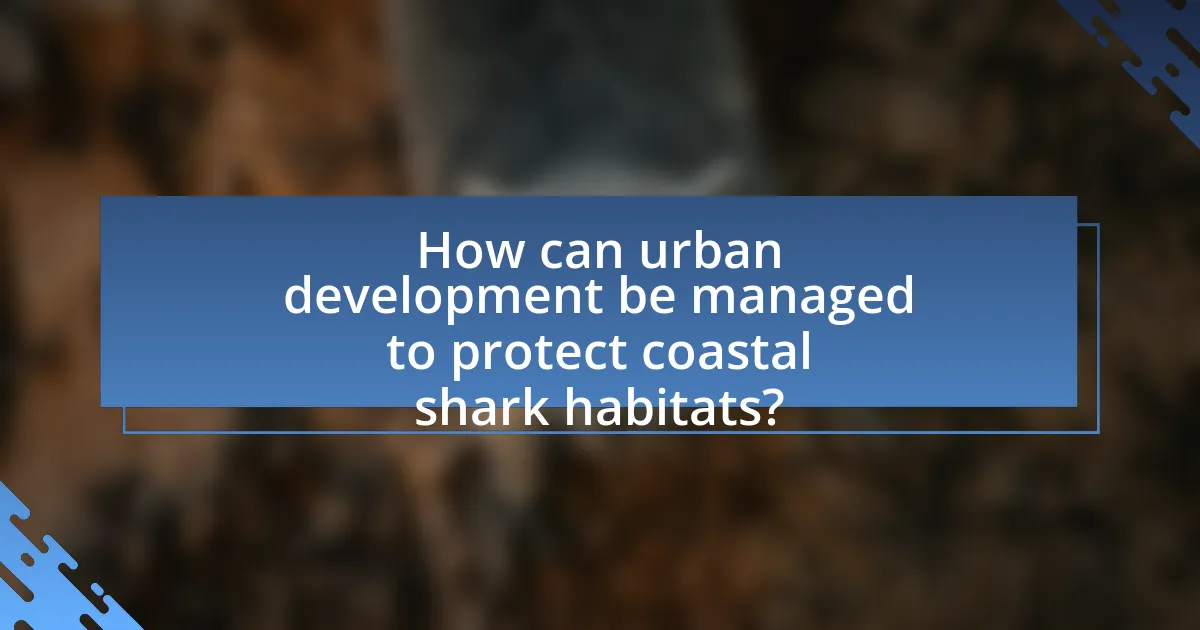
How can urban development be managed to protect coastal shark habitats?
Urban development can be managed to protect coastal shark habitats by implementing strict zoning regulations and establishing marine protected areas. Zoning regulations can limit construction near critical habitats, reducing habitat degradation and pollution. Marine protected areas can provide safe zones where sharks can thrive without the pressures of urbanization. Studies show that areas with effective marine protection have higher shark populations, indicating that such measures are beneficial for their conservation. For instance, the Florida Keys National Marine Sanctuary has demonstrated that protected areas can enhance biodiversity and support shark populations, underscoring the importance of strategic urban planning in coastal regions.
What are effective strategies for sustainable urban planning near coastlines?
Effective strategies for sustainable urban planning near coastlines include implementing integrated coastal zone management, promoting green infrastructure, and enforcing strict zoning regulations. Integrated coastal zone management ensures that environmental, economic, and social factors are considered in planning, which helps protect coastal ecosystems, including shark habitats. Green infrastructure, such as wetlands and mangroves, can mitigate flooding and erosion while providing critical habitats for marine life. Strict zoning regulations prevent overdevelopment and habitat destruction, ensuring that urban expansion does not encroach on vital coastal ecosystems. These strategies are supported by studies indicating that sustainable practices can enhance biodiversity and resilience against climate change impacts.
How can zoning regulations help protect shark habitats?
Zoning regulations can help protect shark habitats by designating specific areas for conservation and restricting harmful activities such as industrial development, fishing, and boating in critical shark habitats. These regulations create safe zones where sharks can thrive, reproduce, and maintain their populations. For instance, the establishment of marine protected areas (MPAs) through zoning has been shown to increase shark abundance and biodiversity, as evidenced by studies indicating that MPAs can lead to a 50% increase in shark populations within their boundaries over time. By controlling human activities in these designated areas, zoning regulations effectively mitigate threats to sharks and their ecosystems.
What role do community engagement and education play in conservation efforts?
Community engagement and education are crucial in conservation efforts as they foster awareness, promote sustainable practices, and encourage local stewardship of natural resources. Engaging communities in conservation initiatives leads to increased participation in protecting habitats, as evidenced by programs like the Coastal Conservation Association, which has successfully mobilized local volunteers to restore coastal ecosystems. Education initiatives, such as workshops and school programs, have been shown to enhance understanding of ecological impacts, leading to more informed decision-making regarding urban development and its effects on coastal shark habitats. Studies indicate that communities with strong educational outreach are more likely to support conservation policies and practices, ultimately contributing to the preservation of biodiversity and ecosystem health.
What best practices can developers adopt to minimize environmental impact?
Developers can minimize environmental impact by implementing sustainable design principles, utilizing eco-friendly materials, and prioritizing energy efficiency. Sustainable design principles include integrating green spaces and preserving natural habitats, which can help maintain biodiversity and reduce urban heat. Using eco-friendly materials, such as recycled or sustainably sourced products, decreases resource depletion and pollution. Prioritizing energy efficiency through smart building technologies and renewable energy sources can significantly lower carbon footprints. According to the U.S. Green Building Council, buildings that adhere to these practices can reduce energy consumption by up to 30%, demonstrating the effectiveness of these strategies in minimizing environmental impact.
How can developers incorporate green infrastructure in coastal projects?
Developers can incorporate green infrastructure in coastal projects by integrating natural systems such as wetlands, green roofs, and permeable pavements to manage stormwater and enhance biodiversity. These practices help mitigate flooding, improve water quality, and provide habitats for coastal species, including sharks. For instance, the use of constructed wetlands can filter pollutants from runoff before they reach marine environments, thereby protecting shark habitats from degradation. Studies have shown that green infrastructure can reduce stormwater runoff by up to 65%, significantly benefiting coastal ecosystems.
What are the benefits of conducting environmental impact assessments?
Conducting environmental impact assessments (EIAs) provides critical benefits, including the identification and mitigation of potential negative effects on ecosystems, such as coastal shark habitats. EIAs facilitate informed decision-making by evaluating the environmental consequences of proposed urban development projects, ensuring that stakeholders consider ecological impacts. For instance, a study by the United Nations Environment Programme highlights that EIAs can lead to better project designs that minimize harm to biodiversity, including marine species like sharks, which are vital for maintaining healthy ocean ecosystems. By integrating scientific data and public input, EIAs promote sustainable development practices that protect vulnerable habitats from degradation.
What actions can individuals take to support shark conservation in urban areas?
Individuals can support shark conservation in urban areas by advocating for sustainable coastal development practices. Engaging in local government meetings to promote policies that protect marine habitats is crucial, as urban development often leads to habitat destruction. Additionally, individuals can participate in or organize community clean-up events to reduce pollution in coastal waters, which directly impacts shark populations. Supporting organizations focused on marine conservation through donations or volunteer work also contributes to the protection of sharks. Research indicates that urban runoff and habitat loss significantly threaten shark populations, making these actions vital for their conservation.
